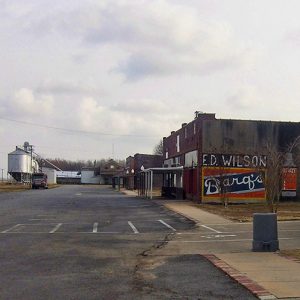calsfoundation@cals.org
Keo Commercial Historic District
The Keo Commercial Historic District in Keo (Lonoke County) was placed on the National Register of Historic Places on June 15, 2011. The district consists of thirty-five structures, objects, and buildings located primarily on the west side of Main Street. The district boundaries are Arkansas Highway 232 on the north, Fleming Street on the south, and an alley on the west. The east side of Main Street is the eastern boundary. The commercial structures of the district display Standard Twentieth Century architecture and Plain Traditional industrial/agricultural styles.
The town of Keo was originally known as Cobb Settlement, Cobbs, or Lafayette Township, and it was situated on Arkansas Highway 15 about one mile north of U.S. 165. The namesake of the town was Lafayette Cobb, who settled in Lonoke County in 1873 and served as the first postmaster. The current location of Keo was called Dunham Station until the Altheimer-Argenta branch of the St. Louis, Arkansas and Texas Railway was established there in 1887. (In 1891, it was reorganized as the St. Louis Southwestern Railway—or Cotton Belt.) The town was renamed Keo, possibly for Miss Keo Dooley, whose father owned farmland in the area. By 1892, Cobbs and Keo existed simultaneously, but Keo’s location on the railroad diminished the importance of Cobbs, and the post office closed in 1916.
Five brick commercial buildings on the west side of Main Street were constructed in 1926 and 1940 after a fire destroyed several frame buildings. The commerce of Keo was driven by cotton, and two cotton gin complexes anchored the boundaries of Main Street. The Morris Cotton Gin on the north was built circa 1940 and consists of the gin, two seed houses, and a scale house. The Cobb Cotton Gin complex to the south contains twenty-two structures dating from the turn of the century to the 1950s. This complex includes a tenant house, commissary, water tank, and fire hose house, among other industrial structures.
Along with the stores, banks, hotels, and restaurants, there was a shingle factory and sawmill, which provided employment during the off-season for cotton. In 1954, the Cobb Cotton Gin was sold out of the Cobb family and began dealing in soybeans, but it retained its original name. By 1970, Bodie Cobb and Ken Cole took over, but the gin closed in 2008 because it could not compete with modern gins. The office is still utilized by Cobb and Cole. The Morris Cotton Gin closed in 1970 and was vacant until the late 1990s, when an antique store moved in.
Commerce in Keo slowed significantly through the 1970s, but there was a recovery in the 1980s when Plum Bayou Mounds Archeological State Park and the Plantation Agriculture Museum were constructed on U.S. 165. The town attracts tourists today to a nationally known restaurant, Charlotte’s Eats and Sweets, and Morris’ Antiques. Keo provides tourists with an intact look at historical cotton ginning facilities.
For additional information:
Hope, Holly. “Keo Commercial Historic District.” National Register of Historic Places nomination form, 2011. On file at Arkansas Historic Preservation Program, Little Rock, Arkansas. Online at http://www.arkansaspreservation.com/National-Register-Listings/PDF/LN0239.nr.pdf (accessed October 27, 2021).
McGraw, Shirley, and Carol Bevis. Lonoke County, Arkansas: A Pictorial History. Virginia Beach, VA: The Donning Company, 1998.
Holly Hope
Arkansas Historic Preservation Program
 Business, Commerce, and Industry
Business, Commerce, and Industry Early Twentieth Century, 1901 through 1940
Early Twentieth Century, 1901 through 1940 Historic Preservation
Historic Preservation Keo Commercial Historic District
Keo Commercial Historic District  Keo Street Scene
Keo Street Scene 



Comments
No comments on this entry yet.